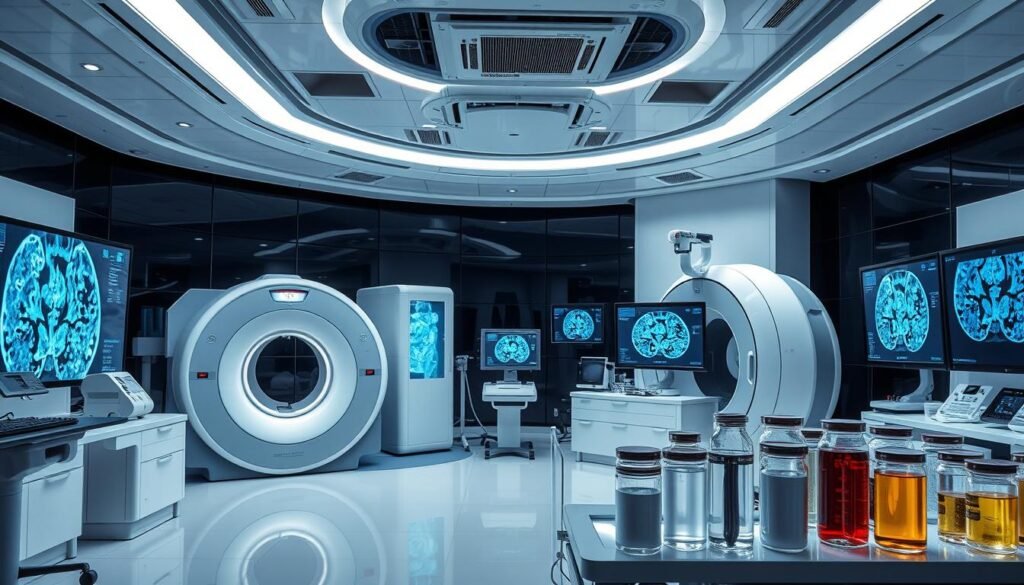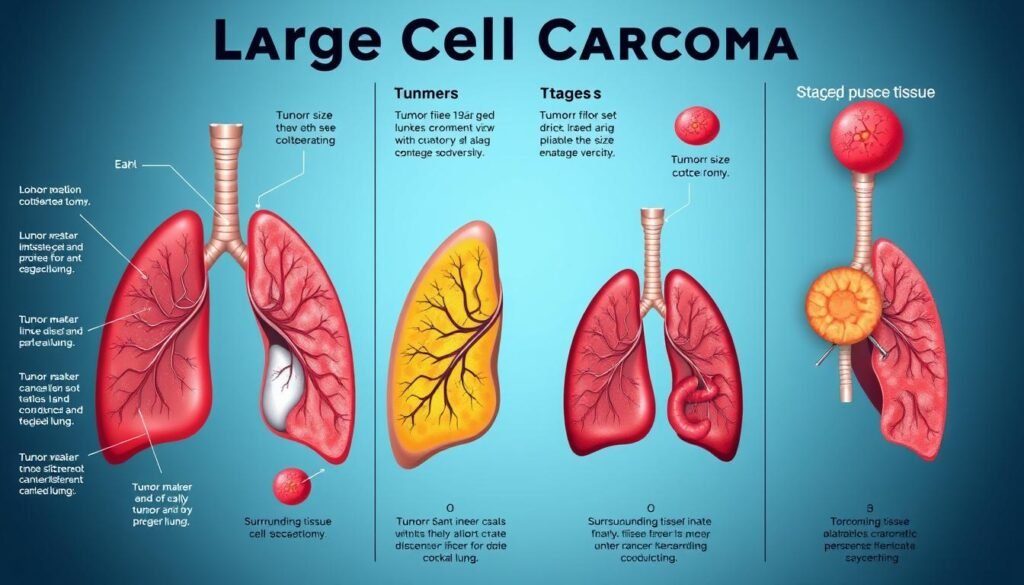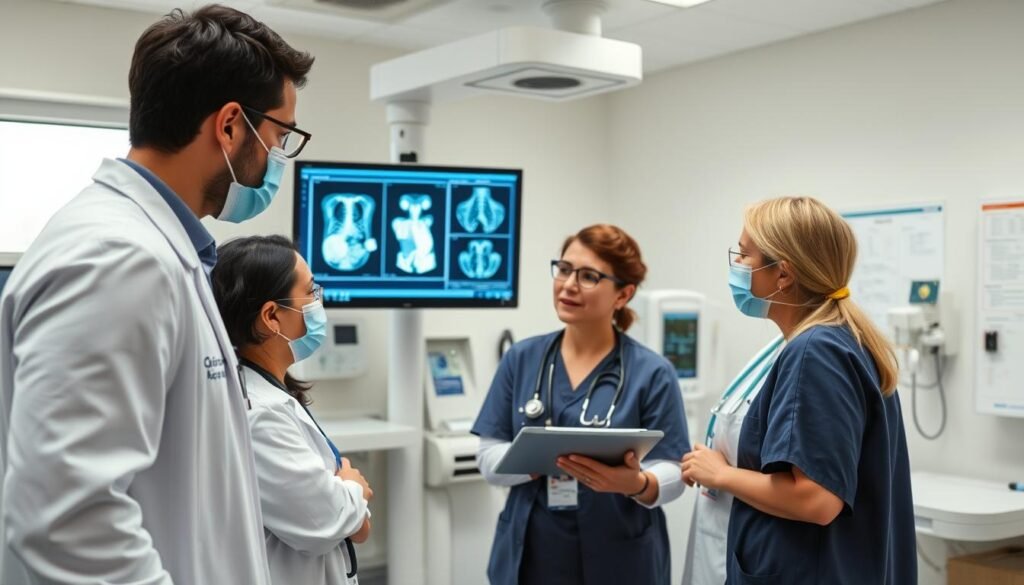Non-small cell lung cancer (NSCLC) makes up about 80–85% of all lung cancer cases. Within this, large cell carcinoma represents 10% to 15% of NSCLC cases. It’s known for its aggressive nature. This type begins in different large cells, complicating its diagnosis. Learning about large cell carcinoma is key for effective management and treating it. This article will give valuable details on diagnosing, understanding symptoms, and treatment options.
Key Takeaways
- Large cell carcinoma accounts for 10% to 15% of existing non-small cell lung cancer cases.
- Recognizing symptoms early can lead to better treatment outcomes.
- Understanding the diagnostic process helps patients become more informed about their condition.
- Advanced imaging techniques play a crucial role in accurate tumor diagnosis.
- Comprehensive care teams enhance treatment effectiveness and patient support.
What is Large Cell Carcinoma and How is it Diagnosed?
Large cell carcinoma is a key type of non-small cell lung cancer. It grows quickly and is highly aggressive. It makes up 10% to 15% of all lung cancer cases. This shows it’s a common type of lung cancer.
Overview of Large Cell Carcinoma
This cancer has big, abnormal cells that appear in different lung areas. It spreads faster than other lung cancers. Since over 80% of lung cancer deaths are tied to smoking, facing this cancer is tough. We need a team’s effort, including top-notch scans and various treatments, to fight it.
Classification within Non-Small Cell Lung Cancer (NSCLC)
As part of the NSCLC group, large cell carcinoma includes types like adenocarcinoma. This category helps doctors figure out treatments and predict outcomes. Sadly, many find out they have it when it’s already advanced. Specific tests can find unique treatment options for each person.
| Stage | 5-Year Survival Rate |
|---|---|
| Stage 0 | 80%-90% |
| Stage I | 60%-80% |
| Stage II | 20%-30% |
| Stage III | 10%-15% |
| Stage IV | 1%-10% |
Symptoms of Large Cell Carcinoma
Knowing the signs of large cell carcinoma is key for catching it early. This lung cancer type shows many symptoms that can harm a person’s health. Seeing these signs early can lead to quick treatment and better chances of recovery.
Common Symptoms to Watch For
Key symptoms of large cell carcinoma include:
- Persistent cough
- Chest pain
- Shortness of breath
- Unexplained weight loss
These symptoms could be confused with other lung issues. That’s why it’s essential to know about them. Being aware helps those at risk seek treatment sooner, improving the outcome.
Symptoms of Metastasis
When large cell carcinoma spreads, it can cause more problems. Common signs of this spread include:
- Jaundice if it reaches the liver
- Headaches if it affects the brain
- Swollen lymph nodes from moving through the lymph system
These signs mean the cancer has grown beyond its original spot. It shows how vital it is to watch for any new or getting worse symptoms right away.
Importance of Early Detection
Finding large cell carcinoma early is vital for improving patient outcomes. It allows for interventions that can greatly increase the chance of successful treatment. Patients with an early diagnosis have more treatment options. This can greatly improve their chances.
Why Early Detection Matters
Detecting large cell carcinoma early improves the effectiveness of treatment. An early diagnosis is likely before the cancer spreads. This leads to better treatment results. Early diagnosis is crucial in cancer management. It reduces the time between noticing symptoms and starting treatment, increasing survival rates.
Impact on Treatment Options and Prognosis
Early diagnosis of large cell carcinoma opens up many treatment options. These can include surgeries with less risk. Late-stage disease significantly lowers the one-year survival rate. For instance, stage IV patients have only a 15–19% chance of surviving a year. In contrast, patients found at stage I have survival rates of 81–85%. Early diagnosis and treatment clearly improve patient outcomes.
Diagnostic Tests for Large Cell Carcinoma
Doctors start diagnosing large cell carcinoma with a complete check-up. They review the patient’s medical history and perform a physical exam. This is to understand the patient’s health and symptoms. They then use different tests to find and look at tumors.
Medical History and Physical Examination
Looking into a patient’s past health and habits gives clues about cancer risks. A physical exam helps find signs like swollen lymph nodes or breathing issues. These early steps guide the choice of further tests.
Imaging Tests Used in Diagnosis
Imaging tests are very important for finding tumors in large cell carcinoma. Doctors often use:
- X-rays
- CT scans
- MRIs
These tests take pictures of the lungs and the area around them. They show doctors if there are any unusual growths. People over 50 who smoked a lot might get low-dose CT scans. This helps catch lung cancer early.
Biopsy Techniques
Biopsy techniques confirm if it’s large cell carcinoma. Doctors remove a small piece of tissue to look at it closely. They usually do:
- Needle biopsy
- Thoracentesis
By doing these, doctors can tell if there are cancer cells in the tumor. Finding cancer early with a biopsy can change how a patient is treated, helping them more.

| Diagnostic Method | Purpose |
|---|---|
| Medical History | To assess risk factors and symptoms. |
| Physical Examination | To detect physical signs of cancer. |
| X-rays | To visualize abnormal lung structures. |
| CT Scans | To provide detailed images of lung tissues. |
| MRIs | To evaluate nearby organs and structures. |
| Needle Biopsy | To collect tissue samples from tumors. |
| Thoracentesis | To obtain fluid or tissue from the chest cavity. |
Imaging Tests for Lung Cancer
Doctors use imaging tests to diagnose lung cancer. These tests show the lungs’ structure. This helps find any signs of cancer. X-rays and CT scans are common first steps. They look for growths or other problems. MRI and PET scans provide more details, helping in treatment choices.
X-rays and CT Scans
Chest X-rays can spot lung issues. But, they might miss small cancers early on. CT scans offer a clearer view, finding lung tumors better than X-rays. They show tumors’ size and place clearly.
Advanced Imaging: MRI and PET Scans
MRI scans are used to check if lung cancer has spread to the brain, spinal cord, or liver. They show detailed pictures but take longer. PET scans show where cancer is active using a special sugar. They are good for figuring out cancer’s stage. PET-CT combines both for a clearer picture, helping in accurate diagnosis.
| Imaging Test | Purpose | Advantages |
|---|---|---|
| X-ray | Initial assessment of lung abnormalities | Quick and non-invasive |
| CT Scan | Detailed visualization of lung tumors | Higher sensitivity for tumor detection |
| MRI | Evaluate spread to brain and other organs | High-resolution imaging of soft tissues |
| PET Scan | Identify cancerous activity in cells | Effective for staging and assessing spread |
| PET-CT Scan | Combined imaging for comprehensive analysis | Integration of metabolic and structural data |
Understanding the Staging of Large Cell Carcinoma
The staging of large cell carcinoma is key to planning effective treatment. It uses the TNM staging method. This method looks at tumor size, lymph node involvement, and metastasis. Knowing this system helps doctors talk better and improve treatment plans.
What is TNM Staging?
TNM staging is a way to measure how far large cell carcinoma has spread. It looks at three main things:
- T: Refers to the size and extent of the primary tumor, designated by letters or numbers such as TX, T0, T1, T2, T3, or T4.
- N: Indicates whether the cancer has spread to nearby lymph nodes, classified as NX, N0, N1, N2, or N3.
- M: Signifies the presence of metastasis, with M0 meaning no distant spread and M1 showing that the cancer has moved to other organs or tissues.
Each type of cancer, like large cell carcinoma, has its own TNM classifications. These show its unique behavior. Some subcategories offer more detail, such as T3a or T3b.
Stages of Large Cell Carcinoma Explained
NSCLC stages range from 0 (in situ) to IV (advanced). Each stage shows tumor size and spread:
| Stage | Description |
|---|---|
| 0 | Abnormal cells are there but haven’t spread. |
| I | The cancer is still in one place and can be taken out with surgery. |
| II | The tumor is bigger and might have reached nearby nodes. |
| III | Cancer has spread more to lymph nodes. |
| IV | The cancer has spread to distant organs. |
Knowing these NSCLC stages is crucial for choosing the right treatment. Proper staging helps doctors create customized treatment plans. This improves chances for patients with large cell carcinoma.

Biomarker Testing for Personalized Treatment
Biomarker testing is key in improving cancer treatment for patients. It looks at tumor markers to spot genetic changes. These changes help doctors choose the best treatment for lung cancer. By focusing on these markers, treatments can be customized. This greatly helps in enhancing the outcomes for patients.
What is Biomarker Testing?
Biomarker testing includes various techniques, such as tumor and genomic testing. These tests check cancer cell samples. They can be from biopsies, surgery, or liquid biopsies. Precision medicine is key in cancer care, offering treatments that match each tumor. For lung cancer, tests like whole-exome sequencing and Guardant360 CDx offer detailed insights into a patient’s cancer.
How Biomarkers Influence Treatment Decisions
Biomarker testing is vital in choosing lung cancer treatments. It reveals over 20 different mutations in non-small cell lung cancer (NSCLC). With test results, doctors can recommend the right drugs or trials. For example, for certain mutations in metastatic lung adenocarcinoma, there are specific targeted therapies. These therapies work well and have fewer side effects.
The PD-L1 protein is an example of an immunotherapy biomarker. It guides the use of immune checkpoint inhibitors, adding to the treatment options. Biomarker testing is changing lung cancer care. It leads to better treatment plans and increased survival rates. For more details, visit this comprehensive guide on biomarker testing.
Healthcare Team Involved in Diagnosis
Diagnosing large cell carcinoma involves a skilled Healthcare Team. This team includes various cancer experts, each with their own role. Together, they work to provide the best care, from diagnosing to planning treatments.
Roles of Different Specialists
The team that diagnoses large cell carcinoma includes several specialists. These experts are:
- Oncologists: They lead in treating cancer, offering insights on different treatments.
- Radiologists: They read imaging tests, spotting lung tissue abnormalities.
- Pathologists: By examining biopsy samples, they pinpoint the cancer type for targeted treatment.
- Surgeons: Sometimes, they perform biopsies or surgeries to remove cancerous tissue.
The Importance of a Comprehensive Care Team
Having a coordinated Healthcare Team improves the experience for those diagnosed with large cell carcinoma. Each expert adds key insights, ensuring thorough diagnosis and tailored treatments. This approach is key as genetic differences, such as EGFR mutations or ALK gene fusions, impact both diagnosis and treatment.

Treatment Options for Large Cell Carcinoma
Treatment options for large cell carcinoma vary based on the disease’s stage and the patient’s needs. It’s important for patients and doctors to understand all approaches. This way, they can choose the best action plan.
Surgery as a Treatment Option
Surgery is a key treatment for large cell carcinoma. The method chosen depends on the tumor’s size and spot. Options include:
- wedge resection: removing a small part of the lung with the tumor
- lobectomy: taking out an entire lobe of the lung
- pneumonectomy: getting rid of one lung
Early-stage tumors usually show the best results with surgery. This significantly boosts survival chances.
Chemotherapy and Radiation Therapy
Chemotherapy and radiation often go along with surgery. These treatments can be given:
- Before surgery to make tumors smaller
- After surgery to kill remaining cancer cells
Chemotherapy uses drugs to attack fast-growing cells. Radiation therapy uses strong rays to kill cancer cells. The choice between these depends on the cancer’s stage and how much it has spread.
Innovative Treatment Approaches
New therapies are changing the way we treat large cell carcinoma. Key new treatments include:
- Targeted therapy: aims at specific features of cancer cells, increasing effectiveness and reducing bad effects
- Immunotherapy: boosts the body’s defense against cancer, offering a new way to tackle advanced cases
These innovative treatments are bringing new hope. They promise better results for more patients.
| Treatment Option | Description | Best for Stage |
|---|---|---|
| Surgery | Wedge resection, lobectomy, pneumonectomy | Stage I and II |
| Chemotherapy | Systemic treatment with drugs | Stages I-IV |
| Radiation Therapy | High-energy rays targeting tumors | Stages II-IV |
| Targeted Therapy | Drugs targeting specific cancer traits | Advanced Stages |
| Immunotherapy | Boosts immune response against cancer | Advanced Stages |
Prognosis and Survival Rates
For lung cancer patients and their families, understanding the prognosis is essential. This is especially true for large cell carcinoma. The outlook changes based on cancer stage and personal health.
Factors Affecting Prognosis
Several factors impact NSCLC outcomes. Important ones include:
- Cancer stage at diagnosis
- Type of cancer cell
- General health and fitness of the patient
- Presence of gene mutations
These factors heavily determine survival chances. Early detection often leads to more positive results.
Current Survival Rates in NSCLC
Survival rates for NSCLC change with cancer stage. Here are the numbers:
| Stage | 5-Year Relative Survival Rate |
|---|---|
| Localized | 65% |
| Regional | 37% |
| Distant | 9% |
| Overall (all stages combined) | 28% |
Statistics highlight the value of early diagnosis. Patients found at stage one have about a 65% chance of living five years or longer. But, survival rates fall as the cancer advances. This shows why it’s vital to get treatment early and improve prognosis methods. For more details on lung carcinoma, check this resource.
Resources for Patients and Caregivers
Dealing with lung cancer can be overwhelming for both patients and caregivers. There are many resources available that offer support, education, and a sense of community. These resources help people manage their health and find comfort with others in similar situations.
Support Groups and Organizations
Many organizations provide essential support for those caring for someone with lung cancer. The American Cancer Society (ACS) is key in this. It offers programs that help patients and caregivers connect. They also have a 24/7 helpline (1-800-227-2345) for anytime help.
CancerCare is another important source of support. It offers free services to those dealing with the emotional and practical challenges of lung cancer. This makes CancerCare a top choice for guidance and support.
Educational Materials and Information Networks
Having access to educational materials can make lung cancer seem less daunting. The Patient Advocate Foundation (PAF) provides publications on healthcare access and insurance. Triage Cancer teaches about practical and legal issues through workshops and guides.
For an engaging learning experience, Patient Power has videos and webinars with cancer experts. To find more resources, visit CancerCare’s website. It covers a wide range of cancer-related topics.
| Organization | Resources Offered |
|---|---|
| American Cancer Society | 24/7 helpline, transportation assistance, lodging grants |
| CancerCare | Emotional and practical support, financial assistance |
| Patient Advocate Foundation | Publications, insurance assistance, health care access |
| Livestrong | One-on-one support for treatment and insurance challenges |
| Patient Power | Videos, webcasts, cancer education resources |
Conclusion
It’s key for patients and their families to understand Large Cell Carcinoma (LCC). This cancer grows quickly and has specific signs. Early spotting through the right tests is key. Knowing about your lung health can lead you to get help sooner. This can greatly help your treatment choices and expected health outcomes.
LCC is known for growing fast, doubling in size in just 67 to 134 days. It’s important to know the signs and when to see a doctor. Doing so early on makes a big difference in treatment success. Regular health checks and screenings are crucial for finding it early. This improves the chances of a better recovery. To learn how to be on top of your lung health, check out the importance of regular check-ups.
Talking with healthcare experts and using resources can build strong support for those dealing with Large Cell Carcinoma. Raising awareness about lung cancer and getting screened regularly can lead to better health. This helps patients live a better life while fighting lung cancer.